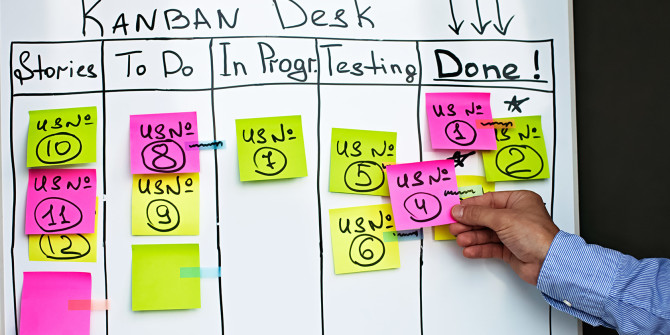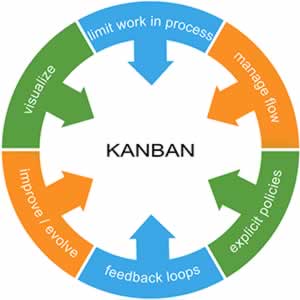The word Kanban, also spelled “kamban” in Japanese, translates to “billboard” (“sign” in Chinese) which indicates “available capacity”. Kanban is a concept related to lean and just-in-time (JIT) production, in which it is used as a planning system that tells you what to produce, when and how much. The Kanban system displays both the process (the workflow) and the actual work that goes through that process. Kanban’s goal is to identify potential problems in the process and solve them so that work can flow through it conveniently at optimal speed or productivity.
THE ORIGINS OF KANBAN SYSTEM
It started in the early 1940s. The first Kanban system was developed by Taiichi Ohno (industrial engineer and businessman) for Toyota in Japan. It was created as a simple planning system to control and manage work and inventory in an optimal way at each stage of production. A key reason for Kanban’s development was Toyota’s inadequate productivity and efficiency compared to its American auto competitors. With this method, Toyota has created a flexible and efficient just-in-time production control system that has increased productivity while reducing the inventory of raw materials, semi-finished products and finished products at high costs. The Kanban system ideally controls the entire value chain from the supplier to the end consumer, helping to avoid interruptions and the storage of the goods in the various phases of the production process. Kanban requires continuous monitoring of the process. Particular attention should be paid to avoid “bottlenecks” which could slow down the production process. The goal is to achieve greater productivity with shorter delivery times.
THE KANBAN METHOD TODAY
While the kanban was introduced by Taiichi Ohno into the manufacturing industry, David J. Anderson was the first to apply the concept to IT, software development and knowledge work in general, in 2004. David put together the works of Taiichi Ohno, Eli Goldratt, Edward Demmings, Peter Drucker and others to define the Kanban method, with concepts such as pull systems, queuing theory and flow. His first book on Kanban – “Kanban: Successfully Evolutionary Change for your Technology Business”, published in 2010, is the most complete definition of this method for knowledge work. Kanban Board is a process of gradually improving whatever you do, be it software development, IT, personnel, hiring, marketing and sales, purchasing etc. In fact, almost all company functions can benefit from the application of the principles of the Kanban Methodology, which draws from principles elaborated by experts like Don Reinertsen (author of Principles of Product Development Flow), Jim Benson (pioneer of Personal Kanban) and many others.
THE 4 MAIN PRINCIPLES OF KANBAN
Unlike other workflow management methods that impose change from the beginning, Kanban is about evolution, not revolution. It is based on the fundamental truth that you need to know where you are before you can reach your desired destination. Below we list and explain the 4 main principles of this system.
1. View the work: by creating a visual model of your work and your work flow, you can observe how it moves through the Kanban system. Making work visible with blocks and queues immediately leads to greater communication and collaboration. This helps teams see how quickly their work is moving through the system and where they can focus their efforts on increasing the flow.
2. Limit work in progress: By limiting the amount of unfinished work in progress, you can reduce the time it takes for an item to go through the Kanban system. You can also avoid problems caused by the change of business and reduce the need to constantly redistribute items.
3. Focus on the flow: limiting the work-in-progress makes it possible to optimize the system to improve the work flow, collect metrics to analyze the flow and even obtain the main indicators of future problems. A consistent workflow is essential for faster and more reliable delivery, offering greater value to customers, teams and organization.
4. Continuous improvement: once your Kanban system is active, it becomes the cornerstone for your company. Teams measure their effectiveness by monitoring flow, quality, productivity, lead times and more. Experiments and analyzes can change the system to improve team effectiveness. Continuous improvement is a lean technique that helps simplify workflows, saving time and money throughout the company.
You may also be interested in this CRM review: Kanban Zone

